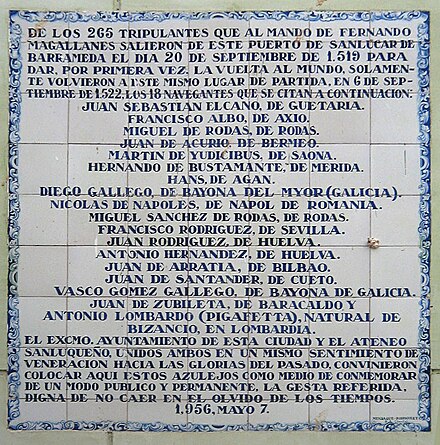Magellan-Elcano circumnavigation
Magellan-Elcano circumnavigation
The Magellan–Elcano circumnavigation, taking place between 1519 and 1522, was the first recorded journey around the world. This itinerary describes their route, from Spain to South America, across the southern Pacific Ocean to Oceania, Southeast Asia, across the Indian Ocean to Africa, and along Africa's west coast back up to Spain.
Of the five ships and 270 men embarking on the journey, only one ship with 18 men aboard finished the trip; some other men straggled back later, but none of the ships. One historian has claimed that making this journey with 16th century technology was riskier than landing on the moon with 20th century technology.
Understand
There had been trade between Asia and the Mediterranean region for centuries via the Silk Road, and around 1300 Marco Polo went east and wrote of the riches there. Then around 1500, many ocean voyages of discovery were launched. In 1492 Christopher Columbus first sailed to the Americas, trying to reach China. In 1498, Vasco da Gama made the first voyage on the Cape Route, reaching Asia by going south and east around Africa. Twenty-odd years later Magellan went the other way, south and west around South America.
 Ferdinand Magellan (Portuguese: Fernão de Magalhães; Spanish: Fernando de Magallanes) was born in northern Portugal (depending on the source near Porto or Vila Real) around 1480. He enlisted in the Portuguese fleet at the age of 25, spending years in India and participating in the Portuguese conquest of Malacca in 1511. Back in Portugal he eventually fell into disfavor with his superiors including the king. As a result of this, Magellan moved to Spain.
Ferdinand Magellan (Portuguese: Fernão de Magalhães; Spanish: Fernando de Magallanes) was born in northern Portugal (depending on the source near Porto or Vila Real) around 1480. He enlisted in the Portuguese fleet at the age of 25, spending years in India and participating in the Portuguese conquest of Malacca in 1511. Back in Portugal he eventually fell into disfavor with his superiors including the king. As a result of this, Magellan moved to Spain.
The Spanish were interested in finding a way to India and the Spice Islands by sailing westwards; this had been the objective of Columbus' voyages two decades earlier. The Treaty of Tordesillas in 1494 split up the world between the Spanish and Portuguese Empires, awarding the latter virtually all of the Old World. Portugal controlled many ports on the Cape Route, so a route via South America would be far better for Spain.
Together with cosmographer Rui Falero (who backed out just before the expedition left Spain) Magellan presented his plans to the king of Spain. In March 1518 they were named captains and Commanders of the Order of Santiago, equipped with ships and supplies and granted great benefits from the upcoming trip including an island for each one, monopoly of the discovered route for ten years and a fifth of the gains of the voyage.
The departure, originally scheduled for July, took place on August 10, 1519 from Seville and a little more than a month later the ships set out from Sanlúcar de Barrameda into the Atlantic. There were about 270 men and five ships in the fleet, Trinidad, San Antonio, Concepción, Santiago and Victoria. Trinidad was the flagship and commanded by Magellan himself. The crew consisted of people from many different southern and central European countries, perhaps most notably the Venetian scholar Antonio Pigafetta, who served as Magellan's assistant and wrote an account of the voyage. The expedition was named Armada de Molucca, the Fleet of Molucca, as its objective was to reach the Moluccas, or Spice Islands. Victoria would be the only ship to complete the circumnavigation, with only 18 crew members aboard.
Magellan himself died in combat on Mactan Island in the Philippines a little more than halfway into the journey. Lapu-Lapu, the local leader who led the forces that killed him, is regarded as a national hero in the Philippines. The trip onward to the Spice Islands and back to Spain was commanded by Juan Sebastián Elcano, native of Getaria in the Basque Country. A soldier and later a merchant captain, he joined the expedition as a subordinate officer. After the demise of captains and officers during the trip, Elcano was the commander who completed the circumnavigation and was awarded a coat of arms by the Spanish king, together with a pension. However, Elcano returned to the seas in 1525 as one of the commanders of the even more unlucky Loaísa expedition, whose goal likewise was to get to the Spice Islands via America, and died of malnutrition in July 1526 somewhere in the Pacific Ocean.
Elcano's male heirs did get the promised island; they were given the hereditary title Margues de Buglas, and "Buglas" is an obsolete name for the large and fairly rich Philippine island now known as Negros. The title has survived into the 21st century; the current Margues lives in Silay, a scenic town in Negros Occidental province with many old Spanish buildings.
English privateer Sir Francis Drake made the first circumnavigation under continuous command, from 1577 to 1580.
Prepare
If you want to make the trip as similar to Magellan's as possible, using a boat is the way to go; a sailboat does not require fuel and would be more like the original voyage than a powerboat. Digital nomads (people who work via the Internet while travelling) could cruise on a sailboat that circumnavigates the world over several years and perhaps earn enough to cover their costs.
Sailing your own ship around the globe is much easier now than in Magellan's time, especially if you avoid the difficult passages through the Straits of Magellan and round the Cape of Good Hope by using the Suez and Panama canals (on the other hand, that means considerable backtracking or missing out many points along the route). However it is still a major undertaking; it requires plenty of prior sailing experience, and a lot of money, preparation and time. A description of such a project and its risks is beyond the scope of a travel guide, though our Cruising on small craft article covers some of the basics.
For most travellers flying will be easier and safer; a Round-the-world flight may be appropriate. Be aware that this trip will entail destinations away from major international airports. To save miles on your round-the-world ticket (should you opt for one), use it for longer flights only and travel "locally" by budget airlines or overland. An alternative might be to choose a round-the-Pacific flight to reach many of the itinerary's destinations and book other flights for the rest of the route.
Many destinations on this route are prone to severe weather during certain times of the year – the tropics have rainy seasons and typhoon while the Austral winter (Northern Hemisphere summer) in the southernmost part of South America means snow and windchill. Weather-wise, the optimal time to make this trip would maybe be starting in February or March; assuming you want to make the trip in 3-4 months or less (of course the trip can be made in just a couple of weeks rushing from place to place).
Present day sights related to this journey as well as route and vehicle suggestions for getting from place to place along the expedition's voyage in the present day are written in italics in the itinerary below.
Get in
See also: Seville#Get in
The expedition started and ended in Seville, a city that is connected to the Atlantic Ocean by the Guadalquivir river. Some accounts regard Sanlúcar de Barrameda at the mouth of the river as the start and ending point of the journey.
Seville has its own airport and the one in Jerez de la Frontera is the closest passenger airport to Sanlúcar de Barrameda. However, it is also possible to fly to an airport with better flight connections such as Madrid-Barajas Airport, Malaga or even Lisbon and travel the last section by bus, train or rental car.
Go
<mapframe text="Magellan-Elcano Circumnavigation" width="1000" height="400" latitude="0" longitude="0" align="center" zoom="2" show="see"> { "type": "FeatureCollection", "features": [ { "type": "Feature", "properties": { "name": "GPX track", "cmt": "navy" }, "geometry": { "type": "LineString", "coordinates": [ [ 179.99, 0.014 ], [ 144.77, 13.48 ], [ 125.724, 11.031 ], [ 125.719, 10.744 ], [ 125.077, 9.906 ], [ 123.903, 10.291 ], [ 124.012, 10.312 ], [ 118.77, 9.73 ], [ 115.04, 4.92 ], [ 127.456, 0.678 ], [ 128.176, -3.694 ], [ 124.95, -8.96 ], [ 18.472, -34.358 ], [ -23.604, 14.912 ], [ -6.369, 36.780 ], [ -5.999, 37.383 ], [ -5.991, 37.370 ], [ -6.355, 36.789 ], [ -16.27, 28.44 ], [ -23.92, 16.28 ], [ -34.945, -8.360 ], [ -43.139, -22.944 ], [ -57.57, -34.74 ], [ -65.62, -45.05 ], [ -67.718, -49.316 ], [ -68.431, -52.397 ], [ -74.64, -52.65 ], [ -138.805, -14.816 ], [ -152.1, -10.7 ], [ -179.99, 0.014 ] ] } } ] } </mapframe> <br clear="right" />1519
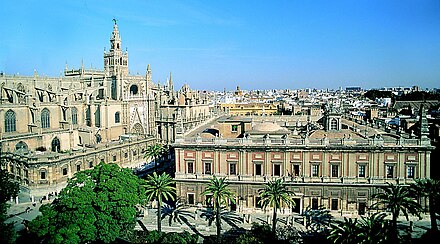
- 10 August 1519 — Seville 📍. The expedition set off from Seville, at the time the Spanish center of trade with the New World, sailing down the Guadalquivir River. It took a few days downstream to Sanlúcar de Barrameda.
The first attraction related to the journey, and the Age of Exploration in general, is the General Archive of the Indies in Seville. This archive of documents related to the Spanish Empire was set together in 1785.
- 20 September 1519 — Sanlúcar de Barrameda 📍. As they reached the coast, they were stopped by the authorities who had doubts a Portuguese would have gotten the Spanish king's authorization for this journey. It took five weeks before they were allowed to continue.
To reach Sanlúcar, you can take the bus or travel by rental car. While you are there, check out the memorial to the survivors of the expedition.
- Once on the Atlantic, they were followed by the Portuguese Navy sent out by the Portuguese king, who weren't at all happy about the Spanish attempt to colonize and trade in "their" hemisphere of the world. Magellan managed to evade the Portuguese ships before arriving in Tenerife 📍 where they replenished their supplies.
Modern travelers can either backtrack to Seville or Jerez de la Frontera and fly from there to Tenerife, or take the bus to Cadiz and ferry (weekly departures) to Tenerife.
- 26 September 1519 – Leaving the Canary Islands. The ships set out on the Atlantic. They passed the Cape Verde 📍 islands on October 3rd, and crossed the Equator on November 20th.
- 29 November 1519 — Cabo de Santo Agostinho 📍, south of Recife is the first place in the Americas Magellan arrived at.
From Tenerife, you can get to Recife via Las Palmas and Sal and take a bus to Cabo. The city features an old town center with Dutch-style urban planning, some forts, the historically significant Olinda right next door, and like much of coastal Brazil, sights related to the Atlantic slave trade which took place in the centuries following this journey. Recife, interestingly, has a modern art museum named after the 20th century graphical artist Aloísio Sergio Magalhães — unclear if he's related to the explorer. In Recife you can also find the 16th century Convento Franciscano de Santo Antônio, described as one of the most beautiful baroque churches in Brazil, and the Museum of the Northeastern Man describing the life of Native Americans in the region.
- 13-27 December 1519 — Rio de Janeiro 📍. Today one of South America's highlights and easily accessible by bus or plane from Recife, in 1519 "January River" was but a huge bay, home to Native Brazilian fishing tribes, discovered by Europeans in 1502 (a French expedition tried to found a city on an island at this bay, almost half a century later). Magellan replenished his supplies and sailed on, now encountering some bad storms where the ship Santiago was damaged.
To continue your journey, first go back to Recife. From there you can choose between three hours on a plane or 48 hours on the road (bus with transfer in Salvador or rental car) to reach Rio de Janeiro.
1520
- 10 January 1520 — Rio de la Plata 📍. In early January the ships arrived at the River Plate and spent a few weeks exploring the region, hoping to find a passage to what is now known as the Pacific Ocean. There is a legend that the Uruguayan capital of Montevideo got its name from one of the members in Magellan’s expedition exclaiming "Monte video" (Latin: "I see a mountain") when seeing Cerro Hill just west of the current city. However, given that the city was founded about 200 years later, it’s possible that it was some other mountain elsewhere on the coast he saw.
The modern traveller can take the plane or bus from Rio down to Montevideo, onwards to Colonia and its stunning old town, cross the Rio de la Plata by ferry to Buenos Aires and continue from there by bus along the coast. If you are in a hurry, fly from Rio to Buenos Aires and on to Rio Gallegos to access points mentioned later in this itinerary. There are no Magellan-related sights here (though there are a great many other sights from the colonial era), as he wasn't the first European explorer to reach this far. That honor goes to Juan Díaz de Solís who was killed by natives upriver four years earlier.
- 27 February 1520 — Bahía de los Patos 📍. The expedition sailed along the coast, hoping to find a passage. In one area they found plenty of penguins instead, and named it Bahía de los Patos or "Bay of the Ducks".
Most likely this is today's Cabo dos Bahias. This nature reserve is particularly famous for the Magellanic penguins(Spheniscus magellanicus), which Magellan was the first European to describe.
- 31 March-24 August 1520 — Puerto San Julián 📍 (Patagonia). With the southern winter approaching, the expedition decided to overwinter in a place Magellan named Puerto San Julián, today a town of about 6,000 inhabitants. However, the crew had grown tired of the trip into nowhere and a mutiny broke out on three of the ships on April 1. Magellan managed to take control over the situation, and executed the leaders of the mutiny but spared many of the participants (including Elcano) as he could not afford to lose too many crew members. Later, Francis Drake would also overwinter here on a round-the-world trip and suffer a mutiny.
The winter was harsh and food supplies scarce. During the stay in Puerto San Julián, they encountered natives of the Patagon tribe. Around 2 m tall, they were regarded as "giants". During the winter, the repaired Santiago was sent out to find the passage. It was wrecked during a storm in the Santa Cruz River (divers recovered the wreck in 1985), but many crew members managed to get back to Puerto San Julián. As this town is several hundred kilometers from the nearest airport, spending several hours on the road is unavoidable even if you fly, so it's probably easiest to just take a bus from Buenos Aires or possibly a rental car. The 2,250-km trip will take about 36 hours. While you're there, don't miss the replica of Magellan's ship Victoria.
- 21 October 1520 — Cabo Virgenes 📍. Setting off from Puerto San Julián, after two months of exploring the coast, they passed a peninsula they named Cabo Virgenes – the southeastern tip of today's Argentine Patagonia. They then entered what today is known as the Strait of Magellan (originally they named it "Estrecho de Todos los Santos", All Saints' Strait). Ships were spread out in order to find the best route. One of the ships, San Antonio, mutinied on Nov 20 and sailed back to Spain where it would arrive half a year later. Its crew of about 50 was jailed, but freed later when the survivors of the round the world trip arrived and told about the hardships of the voyage.
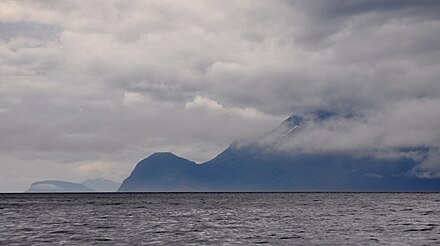
Modern day travelers can travel around by bus or rental car. If you opt for the former, you will likely just get to Rio Gallegos by regular bus and need to take a tour or taxi out to the cape. Rio Gallegos is a hub for travel around the region so it's likely possible to cruise on the strait by boat from here (or take a side trip to Ushuaia, a place sometimes called the southernmost town in the world). The town also has a naval museum, where you can learn about the seas of Southern Patagonia. From Rio Gallegos, continue by bus to Punta Arenas on the Chilean side of Patagonia. On the city's central square, there's a statue of the captain pointing towards the strait and in the Museo Nao Victoria you can see replicas of the Victoria, HMS Beagle and other famous ships that have sailed the region as well as old maritime equipment. From here you can get at least to Cabo Froward and possibly even deeper into the strait. A few kilometers outside the city, there's a nature reserve named after Magellan, as is indeed the whole southernmost region of Chile (Región de Magallanes y de la Antártica Chilena).
- 28 November 1520 — Pacific Ocean 📍. After 38 days of treacherous sailing through the strait, the expedition, now consisting of three ships, reached open seas again. "Say what you will, detractors, he did it", wrote renowned maritime historian Samuel Eliot Morison about this immortal feat of seamanship, more than four centuries later. Magellan named this ocean Mar Pacifico (Peaceful Sea), as the ocean was so quiet and calm compared to the awful winter storms the expedition had had to endure in the southern Atlantic and the strait.
For the 21st century traveller, the Trans-Pacific leg is much more comfortable and safer, even for those sailing their own (modern and well equipped) boat. Those who fly have a choice to make: stick close to Magellan's route by visiting Pacific islands at which he stopped, or bypass those and just fly to the Philippines. Flying to the islands will be quite expensive unless you can include them as part of a round-the world or round-the-Pacific flight.
1521
- 21 January 1521 – Sharks Islands (Puka-Puka 📍). The first European to sail across the Pacific, Magellan of course had no idea how large this ocean was. He expected it to take one month to sail across it, while it in reality took three. There were several islands relatively close to the route where they could have replenished their supplies but they had no clue about them and missed them all. The expedition stumbled upon some of the uninhabited Line Islands. As there was nothing to get from these coral atolls (hence named Islas Infortunadas, Unlucky Islands), food and fresh water supplies started running low and the crew had to resort to eating rats.
You can get to Puka-Puka (part of the Tuamotu Islands of French Polynesia) by flying from Santiago to Easter Island, on to Papeete, Makemo and finally Puka-Puka.
- 4 February 1521 – San Pablo Island (Vostok Island 📍 or Flint Island 📍). The expedition encounters yet another atoll, it's unclear whether this was today's Vostok Island or Flint Island.
These small atolls are still rather inaccessible, and island-hopping in Oceania often entails infrequent and hugely expensive flights.
- 6 March 1521 — Guam 📍. Arriving in Guam in the Mariana Islands group, the expedition finally gets fresh fruit, water and fish. First believing that they've arrived at the northern end of the Spice Islands, they later to their disappointment learn it wasn't true. While in Guam, the ships are boarded and looted by natives, wherefore Magellan names the island group Islas de los Ladrones, "Islands of the Thieves".
To continue from Puke-Puka, backtrack to Papeete and fly to Guam via Tokyo. Travellers who choose to skip the uninteresting atolls can reach Guam by flying from Punta Arenas or another southern Chilean destination up to Santiago and onwards either via the US or via Auckland and Manila to Guam.
- 15 March 1521 — Suluan 📍 – Eastern Samar, Guiuan 📍. Magellan's crew were the first Europeans to arrive in the Philippines, and Guiuan is the first place they visited.
From Guam, fly via Manila to Tacloban, which is the transport hub of its region, and take a minibus to Guiuan. Suluan is reportedly a three-hour boat ride from there. It is possible either to get a direct Manila-Tacloban flight or to travel Manila-Cebu-Tacloban.
- 17 March 1521 — Homonchon 📍. Two days later they arrived at the island of Homonchon, just south of Guiuan. Unlike on Guam, they were warmly welcomed by the natives who brought them fresh food, spices and wine. A setback was that the cartographers measured that they had traveled so far west that they had entered the Portuguese Hemisphere (according to the Treaty of Tordesillas). Nevertheless, the treaty also allowed a party to establish trading posts in the other hemisphere, providing that the particular land was previously unclaimed and the explorer managed to make treaties with the natives. This prompted Magellan to make alliances and treaties with all local chiefs he met.
Homonchon is reportedly accessible by boat from Guiuan.
- 28 March 1521 — Limasawa 📍. Sailing southwest they arrived at the island of Limasawa, where the slave Enrique in Magellan's expedition was able to communicate with the locals. It is unclear where Enrique originally came from (he was captured in Malacca), but this fact makes it possible that he was the very first person to circumnavigate the world. On March 31, the first mass in the Philippines was held here.
Unless you travel by boat, you need to backtrack from Guiuan to Tacloban, take another bus down to Maasin from where you can likely get by bus or taxi to the town of Padre Burgos and a boat to Limasawa. Aside from a town named after him, Magellan-related attractions on this island are of religious character. You can find a shrine on the place where the mass was held, as well as the first cross in the Philippines.
- 7 April 1521 — Cebu City 📍. Arriving in Cebu, Magellan struck up more alliances with local chiefs. Magellan managed to convert Chief Humabon and 2,000 locals to Christianity and promised to make Humabon the superior ruler over the region. Local chiefs agreed to this, except for one – Lapu-Lapu.
For modern day travelers the shortest route is to backtrack to Maasin, and take the ferry to Cebu. Alternately there are ferries and flights from Tacloban to Cebu. In Cebu City you can see Magellan's cross, a wooden cross planted by Magellan now inside an octagonal building near the Basilica del Santo Niño which has a statue of the Holy Child that Magellan gave to Humabon's wife upon baptism. A few decades after Magellan's voyage, Cebu became the first Spanish colonial city in the Philippines and it has many relics of that period, most notably Fort San Pedro.
- 27 April 1521 — Battle of Mactan 📍 (Lapu-Lapu). A joint force of 49 of Magellan’s crew and some natives from Humabon's and other tribes attacked Mactan Island to force Lapu-Lapu to accept Humabon's (and the Spanish King's) superiority. It was a disaster: as noted by Samuel Eliot Morison, Magellan broke every rule of amphibious warfare doctrine, not caring to time his attack with the high tide, not attempting surprise, and most probably trusting in divine intervention. The attackers soon discovered themselves far outnumbered by Lapu-Lapu's warriors (numbering up to 1,500) and coral reefs prevented the ships from getting within gun range of the island. Magellan died in battle and his body was taken as a war trophy by Lapu-Lapu, never to be seen again.
Today the main city of the island is called Lapu-Lapu, and Cebu City and Lapu-Lapu are the two most important towns in the large urban region Metro Cebu. Lapu-Lapu has the country's second most important airport, Mactan-Cebu International Airport, and a statue of the chief is a tourist sight nearby, with a monument to Magellan close to it. The battle took place where the monuments now stand. The airport has many domestic and international flights. One can reach it via Manila, but many travellers prefer to enter the country via Cebu because that airport has fewer hassles and is nearer the center of the country. If budget permits, the Shangrila luxury hotel is close to the airport and the monuments; in general Lapu-Lapu is full of luxury resorts with beaches and diving expeditions.
- 2 May 1521 – Leaving the Visayas. With Magellan dead, the relations between the locals and remaining Europeans soured quickly. Afraid that the Europeans now would try to conquer the domain of Humabon and kill him, natives poisoned several crew members including João Serrão, captain of Concepción and leader of the expedition after Magellan's death, but the expedition members managed to fight their way out and sail away. Meanwhile the slave Enrique escaped from the Europeans and there are no records of him afterwards. As the crew had been decimated to the point that there weren't enough men for three ships, Concepción, the least seaworthy of them, was burned in the waters near Bohol. The two remaining ships sailed west, still searching for the Spice Islands.
Today Bohol is a major tourist destination, especially the resort area of Panglao Island. It is easily reached by ferry from Cebu.
- 21 June 1521 Palawan 📍. The westernmost island of the Philippines, called the "Land of Promise" by the chronicler Pigafetta. The crew was very happy to find an island to replenish their food stock. Here they met some Moro (Filipino Muslim) pilots who guided them onwards through the shallow waters.
Today, Palawan is a popular tourist destination, especially for divers. There are flights from Cebu or Manila, and ferries from Cebu, Manila or Iloilo City. From Bohol, the quickest route would be to return to Cebu by ferry then fly. Alternately, one could take a shorter ferry ride to Dumaguete, then bus to Bacolod, ferry to Iloilo and another ferry to Palawan.
- 17 August-21 September 1521 — Brunei 📍. The expedition reached Brunei and stayed there for 35 days. They were impressed by the wealth of the rajah who however wasn't interested in their goods.
From Palawan, fly via Manila to get to Brunei. Alternately, fly direct From Puerto Princesa, Palawan, to Kota Kinabalu, Malaysia, then get another flight or travel along the Borneo coast to Brunei. Also in this day travellers can be impressed by the wealth of the sultan of Brunei for instance in the Royal Regalia Museum and outside the palace.
- 8 November-21 December 1521 — Tidore 📍, Moluccas. Sailing back around Borneo and through the Sulu Islands off Mindanao, the expedition now consisting of 115 men and two ships finally reached the Spice Islands about two years and two months after they left Spain.
The crew got lucky this time; just a few days earlier a Portuguese Navy detachment that had been searching for them for two years sailing the shorter route across the Indian Ocean had been expelled from the island by the local rajah and sailed back to Portuguese Malacca. The Spanish expedition got along with the locals much better and a few weeks later the ships were loaded with valuable cloves as well as supplies for the crew. However, when it was time to depart, they noticed that Trinidad was leaking badly and it had to stay behind for repairs. Commanded by Juan Elcano, the slightly smaller ship Victoria continued westwards on December 21 as the sole ship left of the expedition. Today, one should definitely not follow this part of the expedition's sea route. The waters around Mindanao are infested by both radical Islamicists and more-or-less secular pirates, and tourists have been kidnapped and murdered in the area in this century. In particular, the Sulu Islands region is extremely dangerous. If you are travelling by boat, going around the west side of Borneo is much safer, and a stop in Kuching might be interesting. The easiest way to take this leg is by flying to Jakarta and on to Ternate, from where Tidore is just a short boat trip away. Less developed and touristy than Ternate, here you can see Spanish fort ruins, attractions from the sultanate era (including a reconstructed palace) and a memorial to the Magellan expedition. If visiting in June-August, you can also see and smell cloves being harvested and dried.
- 29 December 1521 — Ambon Island 📍. Victoria made a final stop in the Spice Islands. Ambon (Pattimura Airport) is a short plane hop away from Ternate.
1522
- 25 January 1522 — Timor 📍. Victoria made a stop in Timor (it's not clear where on the island) before heading southwest into the Indian Ocean. The Indonesian western half of the island (El Tari airport) is accessible via Makassar. Getting to East Timor entails a long detour, flying either via Singapore or via Jakarta and Bali.
- 6 April 1522 – Trinidad sailed east. After a few months of repair, the flagship Trinidad left Tidore, aiming to sail back to Spain the same way it came. It proved to be a bad decision; as they weren't familiar with the wind patterns of the Pacific, they drifted north almost all the way to Japan. When they managed to return south, the barely seaworthy flagship was captured by the Portuguese and sank in a storm while anchored. Four of Trinidad's crew made it back to Spain several years later.
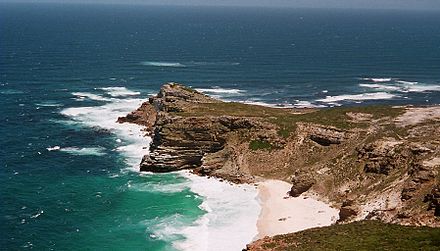
- 19-22 May 1522 — Cape of Good Hope 📍. The crossing of the Indian Ocean took a toll on the crew, just like the crossing of the Pacific. Victoria started taking in water. Moreover they ran out of salt, so fish and meat spoiled quickly in the tropical climate. Pumping water out of the ship while living on water and rice, the exhausted crew entered the Atlantic four months after leaving Timor.
Getting to the Cape of Good Hope requires several flights, usually starting by flying back to Jakarta and eventually to Johannesburg and onwards to Cape Town on a domestic flight. Singapore Airlines flies from Singapore to Cape Town with a stop in Johannesburg and Dubai Airlines has good connections to both Southeast Asia and South Africa. From Cape Town you can get to the Cape of Good Hope (some 60 km south) by rental car, on a tour, or by taking the train to Simon's Town and hiking, cycling or hitchhiking the last 20 km. As many European explorers had passed this point before, there are no memorials related to this particular expedition. Instead, you'll find the cross of Vasco da Gama, the first European to sail the Cape Route about a quarter century earlier. This is by the way not the southernmost point of Africa: that's in Agulhas National Park, around 400 km further southeast.
- 9 July 1522 — Santiago 📍, Cape Verde. From Africa's southwestern tip, they sailed north along the coast. Desperate to get supplies and slaves to man the pumps (tens of the ship's crew had died from scurvy and disease since they left Asia), Elcano sailed to the Cape Verdean island of Santiago, which was a Portuguese colony, probably landing in the old capital of Cidade Velha. He pretended to be arriving from the Americas, and managed to get some supplies. On Cape Verde they were puzzled that the local calendar was one day ahead of the ship's (they'd lost one day by sailing around the world westwards). By accident, however, the Portuguese learned that the ship was carrying cloves and cinnamon and thus was part of the mysterious Spanish expedition to Southeast Asia. Elcano managed to escape, leaving 13 men behind, including Pigafetta. Everyone eventually managed to get back to Spain.
From Cape Town, you can fly via Luanda to Praia on Santiago, or alternatively via Johannesburg and Dakar. Cidade Velha is 10 km west of Praia. The town, which was the first European town in the tropics, is made up of colonial buildings and ruins.
- 5 September 1522 — Sanlúcar de Barrameda 📍. About three years after leaving, the expedition consisting of just one ship and a crew of 18 arrived in Spain.
- 8 September 1522 — Seville 📍. Sailing up on the Guadalquivir River, they reached Seville on September 8, 1522. Elcano and the survivors were hailed as heroes.
To complete the circumnavigation, fly from Praia to Lisbon and take a plane or bus to Seville (with or without a side trip to Sanlúcar de Barrameda).
Aftermath
The expedition itself was a disaster; of the crew of 270, more than 200 perished including all the five original captains. They also brought back just one shipload of (very valuable) spices. Nevertheless they also brought back valuable information about parts of the world Europeans had never visited before and the size of the Pacific Ocean and therefore the size of the Earth itself. While the Spanish didn't get a foothold in the Spice Islands, Magellan's trip nevertheless helped establish the Philippines as a Spanish colony in Asia, accessed through Central America.
Stay safe
This itinerary takes you through several parts of the world. Some countries on the trip have high crime rates (Brazil, South Africa), and severe weather and tropical diseases are a risk in many places. Consult the individual country guides for precautions.
If you're doing the route by boat, there are additional hazards. Both the Cape of Good Hope at the southern tip of Africa and Cape Horn south of South America are notoriously difficult passages. Also, the area around Mindanao, especially the Sulu Islands, is infested with pirates.

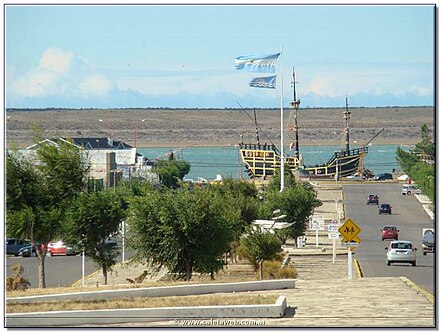

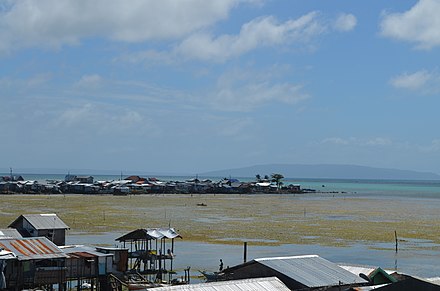
%2C_The_Moluccas_(Maluku)_(15182126636).jpg/440px-Pulau_Maitara_and_Pulau_Tidore_from_the_Floridas_Restaurant_in_Pulau_Ternate_(Ternate_Island),_The_Moluccas_(Maluku)_(15182126636).jpg)
